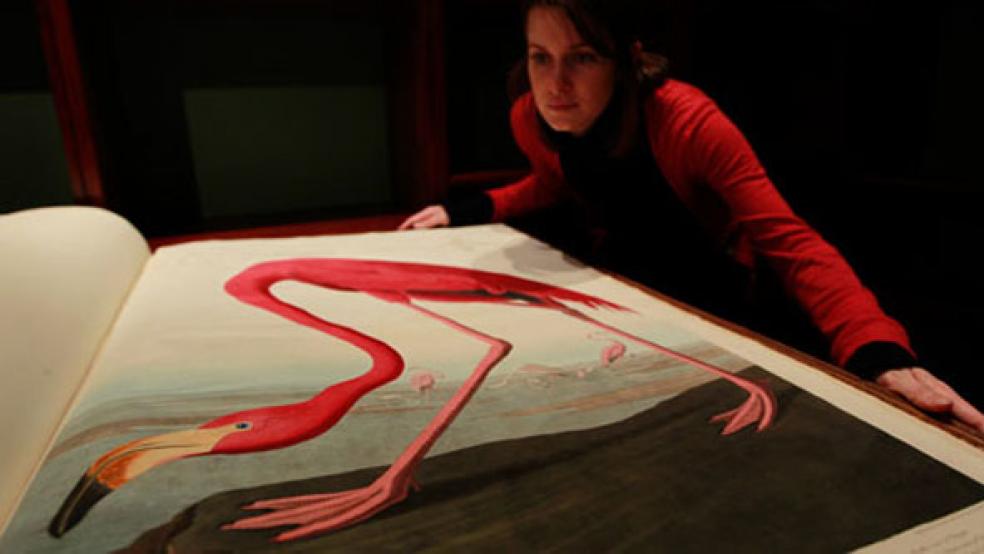Bird experts and rare book collectors worldwide are aflutter after Audubon’s Birds of America, a beautifully illustrated early-19th century gem of Americana, art and natural history, sold for $11.6 million at auction on Tuesday. Sotheby’s, which handled the sale in London, described a scene of "fiery enthusiasm" as four collectors bid against one another, in person and by phone, driving the price far beyond presale expectations of $6 million to $9 million.
The winner was 66-year-old London-based art dealer and bird enthusiast Michael Tollemache, who described his acquisition as "priceless." After the sale, he noted, "I intend to enjoy this for as long as I am able."
Audubon, passionate about birds from a young age, spent 11 years creating his book, from 1827 to 1838. Measuring more than three feet by two feet – the so-called double elephant folio – the book contains 435 individual hand-colored plates, each one a lifesize representation of the birds, many in their natural environment. David Goldthorpe, Sotheby’s director of books and manuscripts, called it a "remarkable work, both in terms of its scale and of the dedication that went into producing it."
Audubon’s total dedication to his work is a key "point of collectability" cited by experts. "Not only is the book a crucial work of American natural history and incredibly beautiful, there’s the larger context of Audubon’s struggle to produce it," said Heather O’Donnell, of Bauman Rare Books in New York City. "At every turn, he faced hardship and discouragement, but he had this single-minded, obsessive, Ahab-like vision of pursuing it against everyone’s advice. The fact that the book turned out so spectacularly gives it an aura that makes people protective of it."
Kenn Kaufman, ornithologist, artist and author of the Kaufman Focus Guides, described Audubon this way:
Mr. Audubon struggled with failure and poverty for much of his life before achieving moderate success in his later years. Not only was he a brilliant artist and a self-taught scientist, he also lived a life that was the stuff of epic legend. He symbolized so many of the romantic aspects of the American frontier that he holds a permanent place in the pantheon of American cultural history.
"Studying birds was how he mastered the world and himself," said the Pulitzer Prize-winning author, Richard Rhodes, of Audubon in his 2004 biography of the naturalist. And noted bird artist Lars Jonsson commented, "There are many layers of quality in Audubon’s paintings. They still today convey a strong feeling of dedication to the subject. Audubon simply loves his birds."
John James Audubon: The Making of an American
Only 100 or so copies of Birds of America exist today, and most are in institutional hands. The last time a copy of Audubon’s Birds of America became available was more than 10 years ago, when it was auctioned by Christie’s International to Sheikh Saud al-Thani of Qatar for $8.8 million. The copy that was sold yesterday came from the estate of the second Baron Hesketh, an aristocratic book collector who died in 1955.
Audubon, who was born in what is now Haiti, took up his passion for American natural history and bird illustrations after his dry goods business failed. Usually short of money, he spent years trying to market his work. When he could not find an American printer willing to take on the project, he traveled to England and found printers in Edinburgh and London. "Even though America proudly claims Audubon," said Kenn Kaufman, "Audubon was always an international figure."
Survival of the Species
Before yesterday’s sale, some collectors and experts had worried that this rare copy of the book would be broken up and its individual plates sold for inordinate amounts — once the standard practice. Most experts agree, however, that today the intact book is more valuable than its individual pieces. "It’s unlikely even an art dealer would break the book," said O’Donnell of Bauman Rare Books. "There’s such a stigma around that now — standards in collecting are such that a dealer would be embarrassed to destroy the book." She added, "I can’t imagine that any of the owners of the Audubon Birds don’t know what they have and aren’t aware of the fact that it’s potentially very valuable."
Some wish the same value of protecting the illustrated birds applied to the living creatures that inspired the book. "Some of the species that Audubon painted are now extinct, and others are seriously endangered," said Kaufman. "It would be a fine thing if this high regard for the paintings could translate into high regard for the survival of the birds depicted. $11 million would go a long way toward protecting vital habitat and securing the future for many of the actual birds of America."


